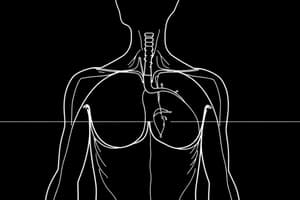Podcast
Questions and Answers
What are the two categories of chemoreceptors that influence ventilation control with regards to their location?
What are the two categories of chemoreceptors that influence ventilation control with regards to their location?
Central and Peripheral Chemoreceptors.
Where are the central and peripheral chemoreceptors located in the body?
Where are the central and peripheral chemoreceptors located in the body?
Central Chemoreceptors: Located in the Medulla. Peripheral Chemoreceptors: Aortic arch and Carotid Sinus.
Both central and peripheral chemoreceptors respond to changes in oxygen partial pressures.
Both central and peripheral chemoreceptors respond to changes in oxygen partial pressures.
False (B)
What is the difference between arterial partial pressure of oxygen [PO2] and arterial concentration of oxygen [CaO2]?
What is the difference between arterial partial pressure of oxygen [PO2] and arterial concentration of oxygen [CaO2]?
In a patient with CO poisoning, why do their PaO2 levels appear normal?
In a patient with CO poisoning, why do their PaO2 levels appear normal?
Do central or peripheral chemoreceptors respond to PaO2 levels?
Do central or peripheral chemoreceptors respond to PaO2 levels?
Between carotid and aortic body chemoreceptors, which ones are more sensitive to PaO2 levels?
Between carotid and aortic body chemoreceptors, which ones are more sensitive to PaO2 levels?
How does the partial pressure of inspired oxygen affect the respiratory drive regarding carbon dioxide level and which chemoreceptors demonstrate this relationship?
How does the partial pressure of inspired oxygen affect the respiratory drive regarding carbon dioxide level and which chemoreceptors demonstrate this relationship?
If hydrogen ions and bicarbonate cannot pass the blood-brain barrier, how do central chemoreceptors monitor vascular PaCO2 levels?
If hydrogen ions and bicarbonate cannot pass the blood-brain barrier, how do central chemoreceptors monitor vascular PaCO2 levels?
Central chemoreceptors directly respond to changes in pH and carbon dioxide levels in the CSF.
Central chemoreceptors directly respond to changes in pH and carbon dioxide levels in the CSF.
If the PCO2 levels in the arteries and the CSF are identical, why does the CSF have a lower pH?
If the PCO2 levels in the arteries and the CSF are identical, why does the CSF have a lower pH?
During a resting metabolic state, at what PaO2 do you begin to see a rapid increase in ventilatory drive induced by peripheral chemoreceptors?
During a resting metabolic state, at what PaO2 do you begin to see a rapid increase in ventilatory drive induced by peripheral chemoreceptors?
In a healthy adult at rest, what is the average pH of their cerebral spinal fluid?
In a healthy adult at rest, what is the average pH of their cerebral spinal fluid?
In a healthy adult at rest, what is the average pH of their blood?
In a healthy adult at rest, what is the average pH of their blood?
Is respiratory drive via central chemoreceptors more responsive to pH or carbon dioxide levels?
Is respiratory drive via central chemoreceptors more responsive to pH or carbon dioxide levels?
Which chemoreceptors detect and respond to acute changes to PCO2 and which ones respond to long-term PCO2 changes?
Which chemoreceptors detect and respond to acute changes to PCO2 and which ones respond to long-term PCO2 changes?
Flashcards are hidden until you start studying
Study Notes
Chemoreceptors and Ventilation Control
- Chemoreceptors are classified into two types: Central and Peripheral, affecting ventilation regulation.
- Central chemoreceptors are located in the Medulla, while Peripheral chemoreceptors are found in the Aortic arch and Carotid Sinus.
Response to Partial Pressures
- Central chemoreceptors only respond to pH and CO2 levels, not to changes in oxygen partial pressures.
- Arterial partial pressure of oxygen (PaO2) indicates the oxygen dissolved in plasma, based on Henry's Law, while arterial concentration of oxygen (CaO2) includes both dissolved oxygen and oxygen bound to hemoglobin.
Implications of CO Poisoning
- In carbon monoxide poisoning, PaO2 levels may appear normal because PaO2 measures dissolved oxygen, unaffected by CO binding to hemoglobin, which impairs the ability to deliver oxygen effectively.
Sensitivity and Function of Chemoreceptors
- Peripheral chemoreceptors respond to PaO2 levels, with Carotid bodies being more sensitive to changes compared to Aortic bodies.
- Increased inspired oxygen fraction decreases peripheral chemoreceptor sensitivity to carbon dioxide (PaCO2), resulting in reduced ventilatory drive for a given PaCO2.
Monitoring CO2 Levels in the Central Nervous System
- Central chemoreceptors can monitor arterial PaCO2 levels despite H+ ions and bicarbonate not passing the blood-brain barrier due to carbonic anhydrase converting these substances back into CO2, which can diffuse across.
- Central chemoreceptors directly react to changes in pH and CO2 concentrations in cerebrospinal fluid (CSF).
pH Variations in Blood and CSF
- Identical PCO2 levels in arteries and CSF lead to a lower pH in CSF because it contains fewer proteins to buffer pH changes compared to blood.
Ventilatory Drive Triggers
- A rapid increase in ventilatory drive via peripheral chemoreceptors begins at a PaO2 of about 60 mmHg.
- The average pH of cerebral spinal fluid in a healthy adult at rest is around 7.3, while the average blood pH is about 7.4.
Responsiveness of Chemoreceptors
- Central chemoreceptors are more responsive to carbon dioxide levels than to pH levels.
- Peripheral chemoreceptors detect acute changes in PCO2, while central chemoreceptors monitor long-term PCO2 alterations.
Studying That Suits You
Use AI to generate personalized quizzes and flashcards to suit your learning preferences.




